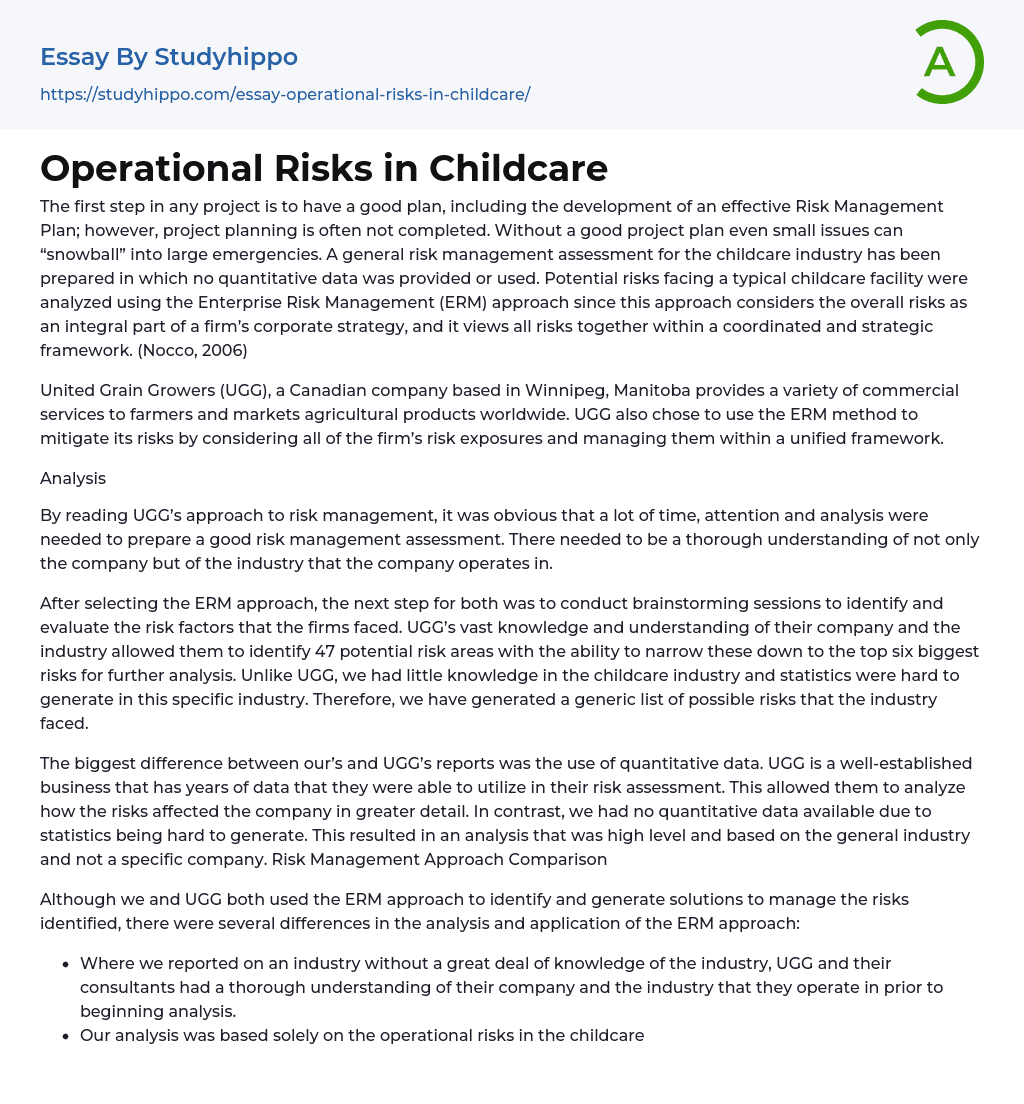The first step in any project is to have a good plan, including the development of an effective Risk Management Plan; however, project planning is often not completed. Without a good project plan even small issues can “snowball” into large emergencies. A general risk management assessment for the childcare industry has been prepared in which no quantitative data was provided or used. Potential risks facing a typical childcare facility were analyzed using the Enterprise Risk Management (ERM) approach since this approach considers the overall risks as an integral part of a firm’s corporate strategy, and it views all risks together within a coordinated and strategic framework. (Nocco, 2006)
United Grain Growers (UGG), a Canadian company based in Winnipeg, Manitoba provides a variety of commercial services to farmers and markets agricultural products worl
...dwide. UGG also chose to use the ERM method to mitigate its risks by considering all of the firm’s risk exposures and managing them within a unified framework.
Analysis
By reading UGG’s approach to risk management, it was obvious that a lot of time, attention and analysis were needed to prepare a good risk management assessment. There needed to be a thorough understanding of not only the company but of the industry that the company operates in.
After selecting the ERM approach, the next step for both was to conduct brainstorming sessions to identify and evaluate the risk factors that the firms faced. UGG’s vast knowledge and understanding of their company and the industry allowed them to identify 47 potential risk areas with the ability to narrow these down to the top six biggest risks for further analysis
Unlike UGG, we had little knowledge in the childcare industry and statistics were hard to generate in this specific industry. Therefore, we have generated a generic list of possible risks that the industry faced.
The biggest difference between our’s and UGG’s reports was the use of quantitative data. UGG is a well-established business that has years of data that they were able to utilize in their risk assessment. This allowed them to analyze how the risks affected the company in greater detail. In contrast, we had no quantitative data available due to statistics being hard to generate. This resulted in an analysis that was high level and based on the general industry and not a specific company. Risk Management Approach Comparison
Although we and UGG both used the ERM approach to identify and generate solutions to manage the risks identified, there were several differences in the analysis and application of the ERM approach:
- Where we reported on an industry without a great deal of knowledge of the industry, UGG and their consultants had a thorough understanding of their company and the industry that they operate in prior to beginning analysis.
- Our analysis was based solely on the operational risks in the childcare industry. UGG, on the other hand, identified both the operational and financial elements of risk (like commodity price risk) in order to identify options to manage these risks. UGG’s exposures to financial risks were one of six of the biggest risk factors that were identified in their risk management approach.
- We created a short generic list of high-level risks in the childcare industry and performed
analysis on each risk, while UGG brainstormed to generate 47 risks and subsequently narrowed this list down to the top six most important risks. This list of six, which included environmental liability, the effects of weather, counterparty risk, credit risk, commodity price risk (financial), and inventory risk, were selected from the list of the 47 total risks.
Generally, UGG’s better understanding of their industry and being able to identify financial risk elements provided UGG with the ability identify risks and solutions that would ultimately lead to being able to make better risk management decisions, which subsequently leads to a more thorough implementation of the tools used to mitigate risk.
Conclusion
Several differences between our’s and UGG’s implementation and approach of the ERM approach to risk management have been identified. It is evident that increased time, members, planning, ideas, data, and knowledge of a business and the industry in which it operates will equate to a more in-depth and precise tool to approach risk management within an organization.
- Doll essays
- Child essays
- Child labor essays
- Childcare essays
- Aviation essays
- Emergency Management essays
- Health Insurance essays
- Insurance essays
- Life Insurance essays
- Public Transport essays
- Transportation essays
- Board Of Directors essays
- Brand Management essays
- Business Ethics essays
- Business Management essays
- Change Management essays
- Comparative Analysis essays
- Decision Making essays
- Dispute Resolution essays
- Knowledge Management essays
- Leadership essays
- Leadership and Management essays
- Manager essays
- Operations Management essays
- Performance Management essays
- Product Management essays
- Project Management essays
- Quality Management essays
- Risk essays
- Risk Management essays
- Scientific Management essays
- Stress Management essays
- supply chain management essays
- Time Management essays
- Total Quality Management essays




